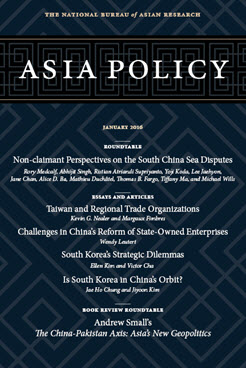Japan's Perceptions of and Interests in the South China Sea
This essay is part of the roundtable ” Non-claimant Perspectives on the South China Sea Disputes.”
China’s assertive and high-handed activities in Asian waters—especially in the East and South China Seas—are generating serious security concerns within the international community. In particular, China’s unique, unilateral positions on maritime issues, which it claims are supported by its wider, and sometimes self-centered, interpretation of the United Nations Convention on the Law of the Sea (UNCLOS) and other established international rules, have puzzled regional states and stakeholders such as the United States. At the same time, disputes in the South China Sea risk escalating into military clashes between the United States and China.
Thus, for Japan, the South China Sea does not simply involve territorial disputes among coastal nations but rather raises a grand issue that could cause a direct military collision, undermining existing stability and potentially leading the region and the world into an unprecedented chaotic situation. This essay examines Japan’s perceptions of and interests in the South China Sea. Japan’s primary concerns in the region are twofold: First, China’s reclamation activities and military buildup could eventually give it strategic control of the sea lines of communication. Second, the potential escalation of tensions between China and the United States, Japan’s key ally, poses a threat to regional stability. The essay then examines Japanese security policy and assesses what actions Japan could take to help stabilize the situation.
An Overview of Japan’s Key Concerns
China’s reclamation and island-building activities. Stretching approximately 1,750 miles from the Bashi Channel/Luzon Strait to Singapore and 1,250 miles from Hong Kong to Brunei, the South China Sea is roughly 9.5 times as large as Japan and includes around two hundred islands, rocks, shoals, and reefs. There are several prominent archipelagos, such as the Paracel Islands and the Spratly Islands, and each has its own strategic significance.
Since 2013, China has started reclamation at seven lagoons and engaged in the construction of artificial islands. Fiery Cross Reef seems to be a core spot that includes full military facilities, most notably a runway and a deep port. Subi and Mischief Reefs, which are about 125 miles apart, are the other artificial islands with runways and port facilities. Japan fears that four other artificial islands with various support facilities could function as outer guard posts for the three main islands with airfields and air-surveillance sites that could enable a potential Chinese air defense identification zone in the South China Sea. These man-made islands, when fully completed, would provide China with strong footholds in the Spratly Islands for controlling most of the sea lines of communication and for monitoring foreign naval and air activities. Moreover, if China in the future ever successfully builds an artificial island at the Scarborough Shoal, there would be a strategic triangle connecting Woody Island, the Spratlys, and Scarborough Shoal that would cover most of the South China Sea. The impact of this strategic triangle would be tremendous for the United States’ and Japan’s strategic planning and could be a game changer in regional power relations.
As a major global power, China has a national objective to be a nuclear power comparable with the United States. However, China lacks long-range bombers and, as a result, naturally depends on its strategic missile forces, including its maritime strategic nuclear capabilities, as a major element. In this context, the People’s Liberation Army (PLA) Navy must maintain a robust nuclear-powered ballistic missile submarine (SSBN) force and protect this force against the antisubmarine warfare capabilities of potential adversaries—especially the U.S. Navy’s nuclear-powered attack submarine (SSN) force. The PLA Navy has completed a new naval base at Sanya on Hainan Island, which is ideal for deploying its SSBN force to patrol in the Indian and the Pacific Oceans.
If the size of China’s SSBN force grows to more than eight submarines, the PLA Navy may establish two or more submarine patrol areas in the Indian Ocean or the western Pacific. The two launching spots together would provide nuclear reach to the United States, casting a dark shadow over the U.S. nuclear strategy and ballistic missile defense posture.
However, Hainan poses one serious problem to the PLA Navy: the base is openly exposed to the South China Sea, and thus is also exposed to the advanced antisubmarine warfare forces of the U.S. Navy. So, for the PLA Navy, SSBN protection in the South China Sea will be another key task. China’s determination to monopolize the southern South China Sea around…
Yoji Koda is a former Vice Admiral of the Japan Maritime Self-Defense Force (JMSDF) and former Commander in Chief of the JMSDF fleet.
About Asia Policy
Asia Policy is a peer-reviewed scholarly journal presenting policy-relevant academic research on the Asia-Pacific that draws clear and concise conclusions useful to today’s policymakers. Asia Policy is published quarterly in January, April, July, and October and accepts submissions on a rolling basis. Learn more


